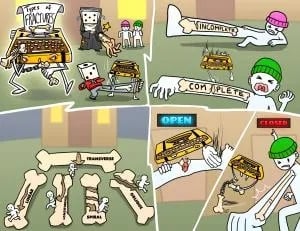SALTER is a mnemonic which stands for S – Straight Across, A – Above, L –Lower or beLow, T – Two or Through, ER – ERasure of growth place or cRush.
- Salter I (Slipped): This is when the fracture line extends through the physis or within the growth plate.
- Salter II (Above): These are when the fracture extends through both the physis and metaphysis.
- Salter III (Lower): This is an intra-articular fracture extending from the physis into the epiphysis.
- Salter IV (Through/Transverse): This is also an intra-articular fracture, in which the fracture passes through the epiphysis, physis, and metaphysis.
- Salter V (Rammed/Ruined): This fracture type is due to a crush or compression injury of the growth plate.
 Picmonic
Picmonic
 |
Fractures types can be classified in various ways, as either displaced or nondisplaced; open or closed; complete or incomplete, or according to the direction of the fracture line. Understanding the difference between the different types of fractures is important in order to provide proper care. |
 |
The Salter-Harris Fracture Classification system is designed to classify physeal fractures based on their relationship to the growth plate. Correct classification is crucial because the type of fracture will determine both treatment and prognosis. SALTER is a mnemonic which stands for S- Straight Across, A - Above, L - Lower or beLow, T - Two or Through, ER - ERasure of growth place or cRush. |
 |
A neurovascular assessment, which is also called a “circ check” is performed to determine if there is adequate circulation and sensation to an extremity. Following trauma (fractures) and vascular surgery, neurovascular checks are important in monitoring for acute compartment syndrome (ACS). Early recognition of ACS can prevent loss of function or loss of a limb. |


